.

How Tall Do Weed Plants Grow?
Cannabis plants can grow monstrously tall or adorably short. Aside from genetics, a range of factors dictate how big your plants will turn out, and understanding these gives you much greater control over the final height and yield of your crop.
Contents:
Cannabis plants, though often considered to all belong to a single species, come in a variety of shapes and sizes. Think about dogs—they’re all one species, yet there’s huge variation between them.
Photoperiod plants, with longer vegetative and flowering phases, tend to grow taller than Autoflowers and F1 Hybrids. For example, in the RQS catalog, Photoperiod seeds range from 60 cm indoors to an exceptional 300 cm for Royal Moby outdoors. In comparison, Autoflower counterparts typically range from 40 to 160 cm. Clearly, Photoperiod plants require extra care to manage their height and avoid surprises!
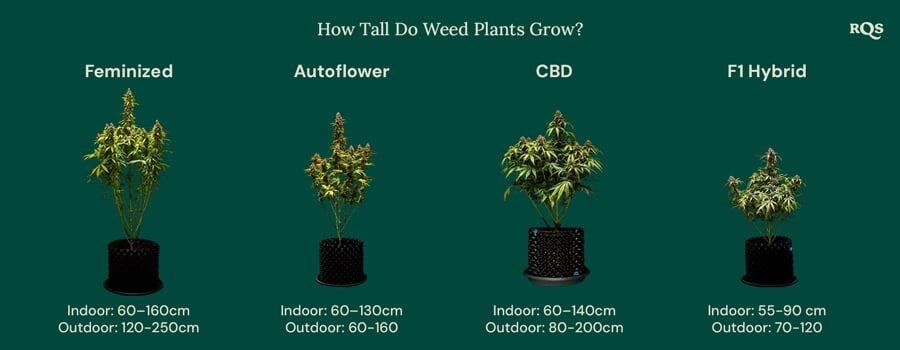
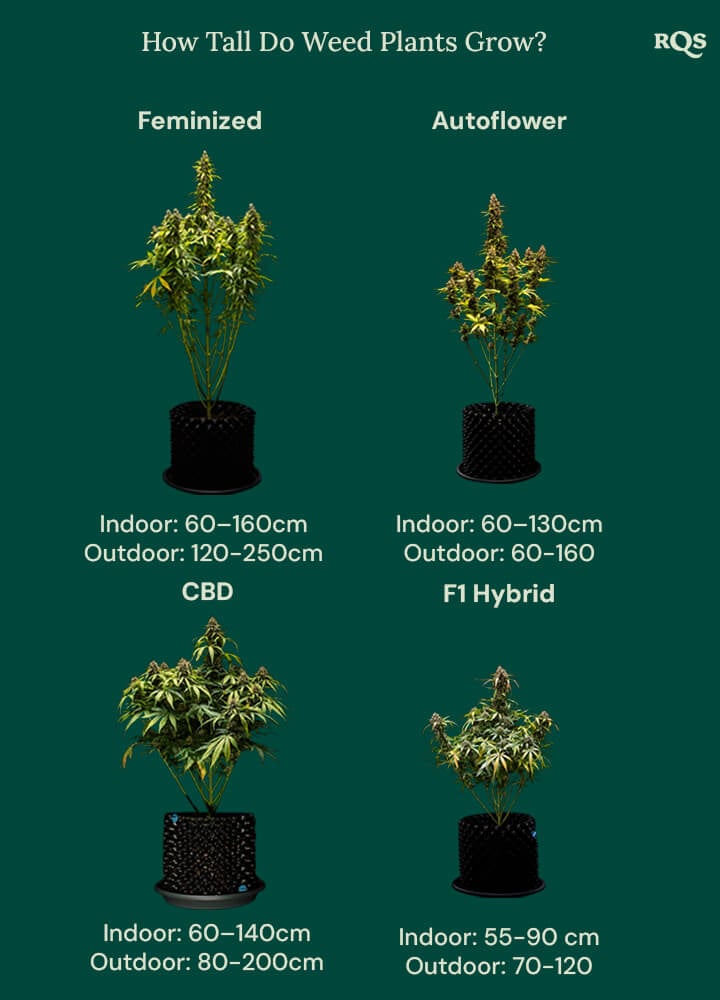
But how can height be controlled, and what factors influence it?
Whether you're a novice cultivator or an experienced gardener, understanding the potential height of your cannabis plants is a skill worth learning. This knowledge helps in arranging your grow space, managing plant care, and ensuring optimal yields. In this article, we’ll help you understand the factors that influence cannabis plant height, the typical height ranges for different types of weed plants, the significance of the flowering stretch, and tips for managing plant height effectively.
Factors That Influence Plant Height
Many factors ultimately determine a plant’s height, and understanding the role that each plays is key to becoming a better cannabis cultivator. While some factors are more influential than others, any could potentially play a deciding role if pushed to the extreme. For this reason, comprehensive knowledge is very helpful.
-
Genetics
Cannabis plants come in various strains, primarily categorised into sativa, indica, and hybrids (a mix between the two). Aside from these, we also have autoflower strains, which contain genetics from Cannabis ruderalis, a subspecies of Cannabis sativa. So-called sativa strains typically grow taller, sometimes reaching up to 3–5 metres outdoors, while so-called indicas are shorter and bushier, averaging around 1.5–2 metres. Hybrids can vary significantly depending on their genetic balance, but tend to grow to around 1–2 metres in most cases.
-
Lighting
Light intensity and spectrum play a major role in determining plant height. Insufficient lighting can lead to tall, leggy plants as they stretch towards the light source. They do this because they have evolved to assume that this means they are growing beneath the cover of taller plants, and therefore stretch in an attempt to break through the canopy. Totally insufficient lighting will ultimately lead to plants that can’t create enough energy to mature and reach their full size.
Conversely, optimal lighting promotes balanced growth and leads to more compact, stockier plants. Lighting should not be used as a tool to control marijuana plant size. Rather, you should always seek to give your plants optimal light.
Light Spectrum
The light spectrum itself can also affect plant height. Red light tends to encourage vertical growth, while blue light supports bushier development and root growth. Adjusting the light spectrum during different growth stages can help control plant height.
This being said, it’s more important to adjust the light spectrum to the plant’s stage of growth, rather than in an attempt to manipulate height. Blue light is best during the seedling and vegetative stages, whereas red light is best suited to the flowering stage (when vertical growth will actually have stopped).
-
Planting Density
High planting density can cause competition for light, leading to taller growth as plants stretch to avoid being shaded. If plants are packed too close together and aren’t trained, you’ll notice the canopy is uneven and ever on the rise.
This can result in taller plants than expected. For example, F1 hybrids like Orion F1, which are typically short and bushy, may grow taller and slimmer under these conditions.
In the Sea of Green (SOG) method, smaller pots are used to fit many more plants into a given area, such as 1 square meter. If larger pots are used and plant density isn't controlled, plants can grow taller and become harder to manage.
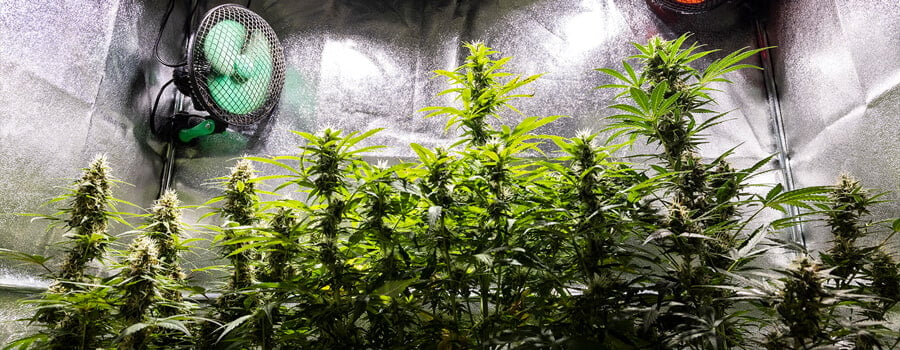
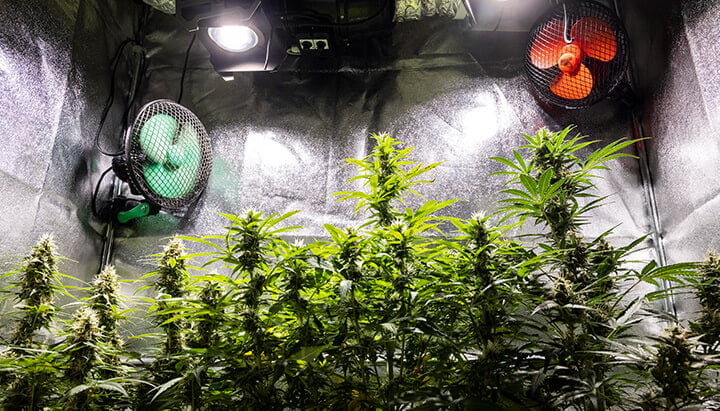
-
Temperature and Humidity
Environmental conditions such as temperature and humidity also influence plant height. Higher temperatures can accelerate growth, while optimal humidity levels support healthy development. Again, as with light, the key is to just optimise these factors (if growing indoors), rather than trying to harness them to adjust the height of your plants.
But if you reverse the knowledge, and you see your plants growing strangely, then you can diagnose which environmental factor might be responsible.
-
Container Size
The size of the growing container dictates how big the root system can become, which in turn affects plant height. Smaller pots limit growth, making it easier to manage plant size, especially in indoor setups. Bigger pots, on the other hand, allow the root system to grow bigger, which in turn allows the entire plant to grow bigger.
Pots are a very good way to influence the final height of your plants, and you absolutely should bear pot size in mind when planning a grow.
Typical Height Range of Cannabis Strains
Using the extensive catalog from RQS, cannabis strains are classified by their growth heights, helping growers plan their operations effectively.
Feminized photoperiod plants are usually taller than autoflowering strains. The former can reach maximum heights of well above 2 metres, while autoflowering strains often max out at around 1 meter. CBD strains, whether photoperiod or autoflowering, come in a range of sizes, just like their THC-rich counterparts. Similarly, F1 hybrids can appear in a range of heights, but tend to be on the smaller and compact side, besides being more homogeneous.
That said, where the plant is grown—i.e. indoors vs outdoors—can influence the expected height of a strain substantially. With that in mind, and using the RQS catalog as a base, we will detail the average heights for different types of common cannabis strains and families, so you can try new strains with more certainty about the outcome.
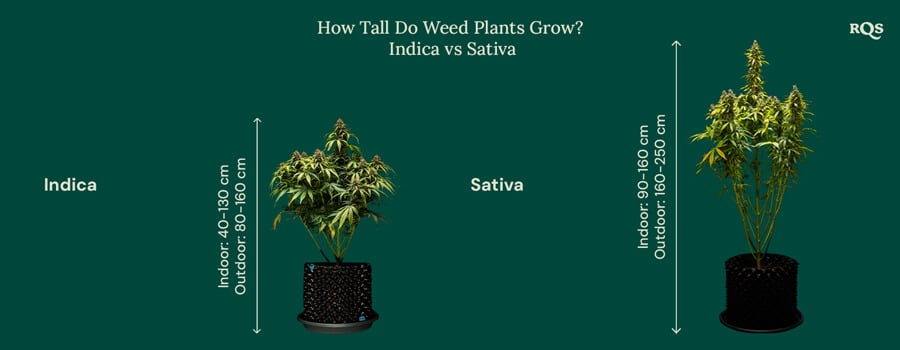
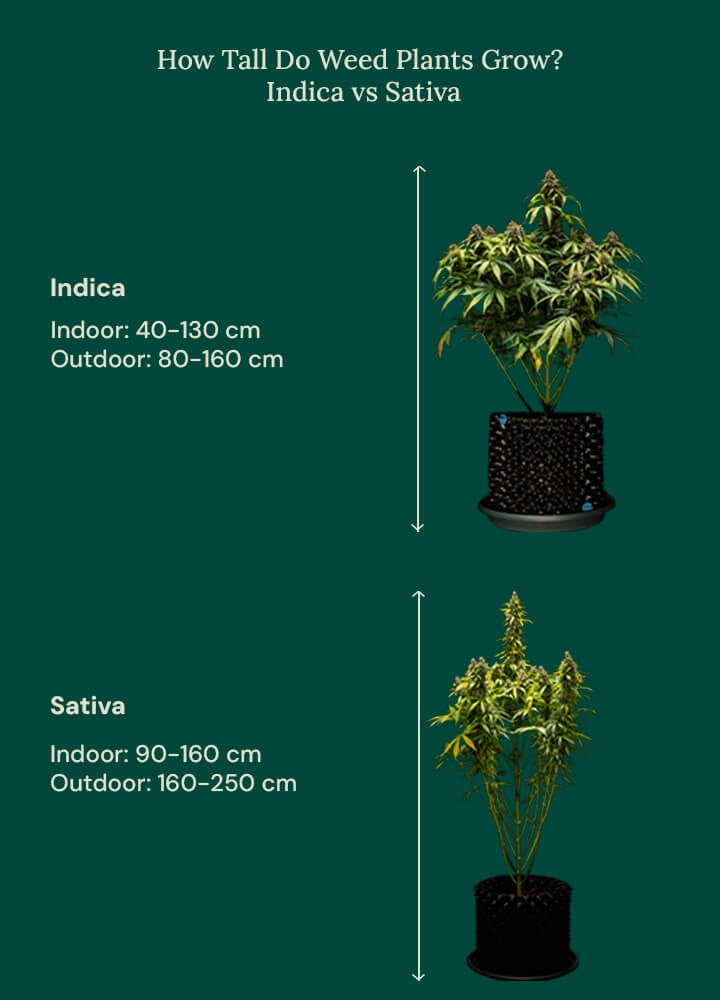
-
Indoor Plants
Indoor cannabis plants tend to be shorter due to space limitations. Pots are often smaller, lighting will be less strong (compared to the sun), and the vegetative stage will likely be shorter—all of which will reduce overall height. Here's the average height for different strain categories:
- Feminized photoperiod: 85 – 125 cm
- Autos: 65 – 105 cm
- CBD: 70 – 110 cm
- F1 hybrids: 60 – 80cm
-
Outdoor Plants
Outdoor plants usually have more room to grow and reach greater heights. Furthermore, they benefit from the unmatched power of the sun and a long growing period. Here are the average heights for outdoor cannabis plants:
- Feminized photoperiod: 150 – 190 cm
- Autos: 85 – 125 cm
- CBD: 110 – 150 cm
- F1 hybrids: 70 – 110 cm
When it comes to indica vs sativa, predominantly sativas are generally significantly taller, as they evolved in regions with longer growth periods, whereas predominantly indicas developed in harsh mountainous regions. Hybrids containing both indica and sativa fall somewhere in the middle, but often lean more towards indica in terms of size, as many breeders purposefully try to limit excessive plant height.
-
Indica
Indica-dominant strains are known for their dense buds and sturdy structure. They generally grow shorter, making them ideal for compact spaces, with maximum heights of 160 cm indoors and 270 cm outdoors.
| Photoperiod |
|
| Autoflower |
|
| CBD |
|
| Photoperiod |
|
| Autoflower |
|
| CBD |
|
-
Sativa
Sativa-dominant photoperiod plants are known for their tall stature and central cola. Indoor plants can reach heights of up to 160 cm, while outdoor plants can grow as tall as 300 cm, though this is rare. Be cautious of their flowering stretch, which can sometimes double their size from the vegetative stage.
| Photoperiod |
|
| Autoflower |
|
| CBD |
|
| Photoperiod |
|
| Autoflower |
|
| CBD |
|
If you're considering growing a strain from a particular family but are unsure about space requirements, refer to the list below:
-
Gelato
Gelato photoperiod strains are celebrated for their vigorous growth and abundant resin production. The predominance of Indica strains in the catalog ensures they typically grow to a moderate size.
- Indoor Height: 85–125 cm
- Outdoor Height: 135–175 cm
-
Haze
Photoperiod Haze strains are famous for their Sativa-dominant traits, characterized by longer branches and a longer flowering period, which contribute to their taller stature.
- Indoor Height: 90–130 cm
- Outdoor Height: 170–210 cm
-
Cookies
Cookies strains are recognized for their dense buds and potent aroma, showcasing a slight leaning towards Indica dominance, which typically yields plants of moderate size.
- Indoor Height: 85–125 cm
- Outdoor Height: 140–180 cm
-
Kush
Kush strains display dominant Indica characteristics, originating from the Hindu Kush mountains, which results in the growth of compact and bushy plants.
- Indoor Height: 80–120 cm
- Outdoor Height: 145–185 cm
-
Afghan
Afghan photoperiod strains are renowned for their resilience and durability, which yield robust plants with a shorter stature. This makes them among the most compact options in the RQS catalog.
- Indoor Height: 70–110 cm
- Outdoor Height: 165–205 cm
-
Growth Phases
What follows are average heights for cannabis plants during their different stages of growth.
- Seedling: Up to 30cm.
- Vegetative: Can grow up to 5cm per day, reaching around 50–100cm by the end of veg, depending on the strain and environment.
- Flowering: Plants can double in size during the flowering stretch, after which they will cease vertical growth and focus on flower development.
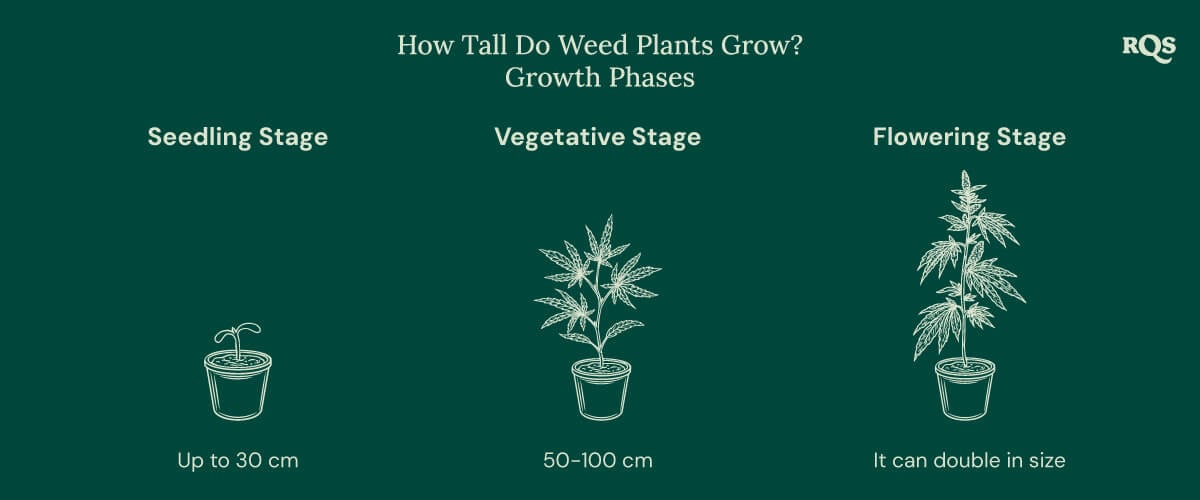
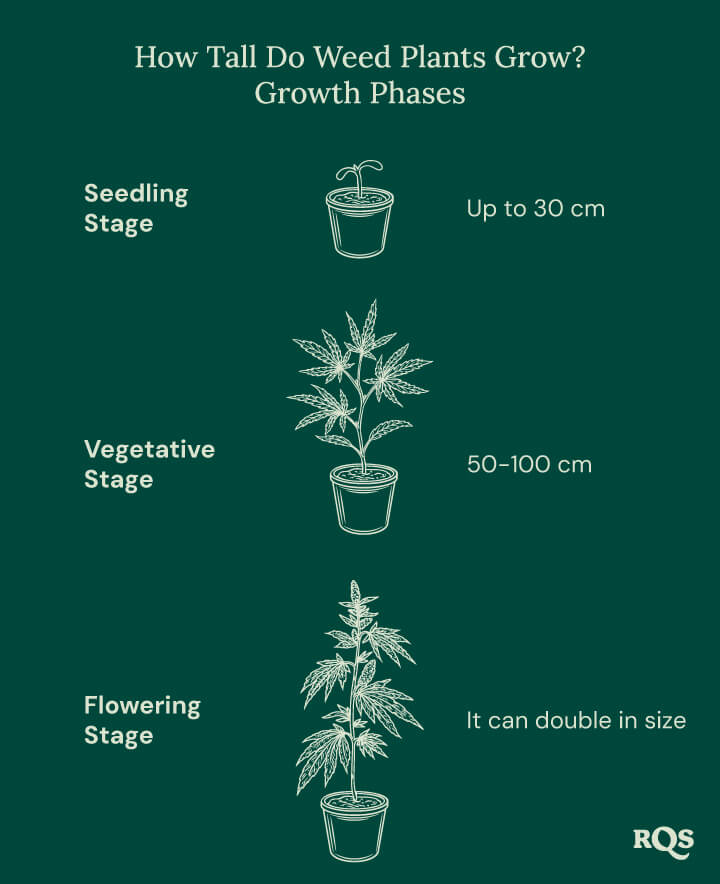
The Flowering Stretch
The flowering stretch describes a period at the very beginning of the flowering phase during which plants experience a significant growth spurt. After this point, plants will stop growing and will spend all their energy producing flowers. This period can last 2–3 weeks, but can be much shorter as well—and certain cultivars may double in size in a matter of days, while others may only add a few inches to their stature. Knowing your plant's genetics helps you to anticipate and manage this stretch effectively, as it can be quite a surprise if you’re not expecting it.
Managing the Stretch
Controlling the stretch of your plants, and therefore their final height, is possible—mostly through employing training techniques. However, it’s important to note that training techniques should be used during the vegetative stage, in anticipation of this stretch. If you seek to control it ad hoc and end up stressing your plant during this stage, you will do more harm than good. If it takes you by surprise, the best thing you can do is try to adapt the environment to the stretch, rather than trying to manipulate the plant.
What Is the Optimal Height?
The optimal height for cannabis plants depends on your grow setup, particularly the size of your tent and the power of your lights, if growing indoors. For those growing indoors or in smaller greenhouses, keeping plants between 80–120cm will ensure that they fit within standard grow tents and receive adequate light penetration.
Outdoors, you can let your plants get as big as they please—if you have the space. The main reason that people might want to restrict the height of plants outdoors is for stealth, as 3m-tall giant weed plants can draw unwanted attention. If this is the case for you, choose a strain that naturally grows small, as you’ll have less work on your hands.
Cultivation Tips for Managing Plant Height
There are many techniques that can be employed to control plant height. Below, we outline the various ways that you can manipulate and manage the height of your crop.
-
Grow Setup and Light Power
Ensure your grow setup provides sufficient light intensity and the correct light spectrum for each growth stage, as this will assure plants that they don’t need to stretch ever-upwards in search of more light. Using powerful lights and adjusting their hanging height can help to control plant growth. Keep the lights low enough to satisfy your plants, but not so low that they burn them.
-
Low-Stress Training (LST) and Topping
LST involves bending and tying down the main stem and branches to create an even canopy and promote bushier, lateral growth. This creates shorter, fatter plants, which, alongside being smaller, also produce a greater number of main colas—meaning more bud for you!
Topping, or cutting the main stem, encourages plants to grow wider rather than taller. From where the cut is made, two new stems will grow out laterally. Once the plant stretches during flowering, you will really notice how this technique stops it from rocketing upwards and instead causes it to shoot outwards.
-
Monitoring and Switching to the Bloom Phase
Regularly monitor plant growth and switch to the flowering phase promptly to prevent excessive height. Switching to bloom early (e.g. after 2–4 weeks of vegetation) can help manage taller strains, and is also necessary if you want to use techniques such as SOG. This involves switching many small plants to flowering early and growing them in close proximity. While the final yield per plant may not seem that impressive, the yield per unit of area will be substantial. Ultimately, SOG is a great method for those who want large yields but would rather keep their plants low.
-
Pot Size
Using smaller pots restricts root growth and limits plant height, as the root systems can’t develop enough to give rise to monstrous plants. This technique is especially useful for outdoor growers with limited space, or who would rather their plants remain inconspicuous.
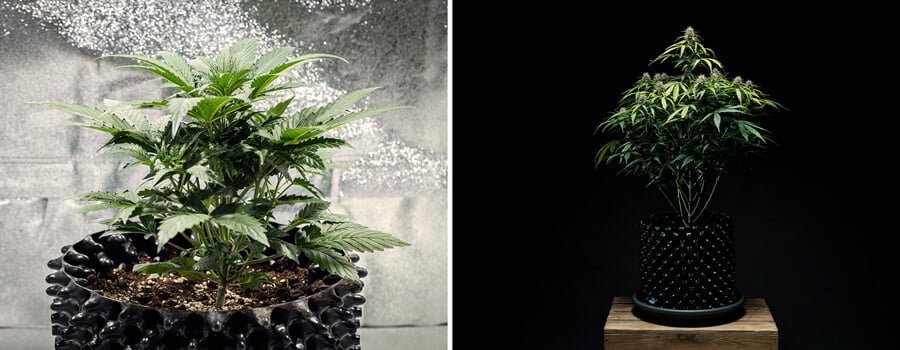
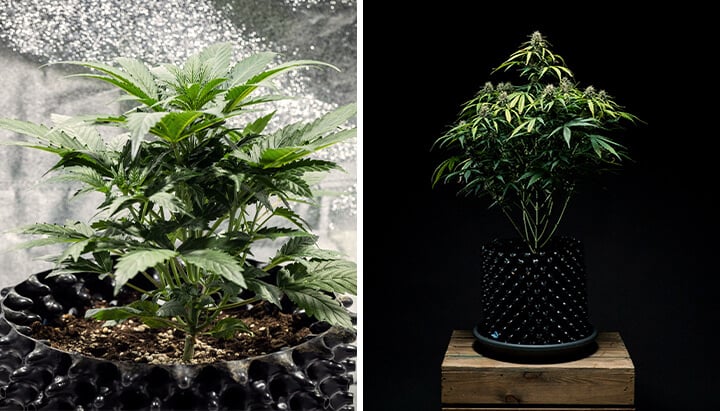
Marijuana Plant Height: Highly Variable!
Understanding how tall weed plants can grow is very important when it comes to planning your grow and ensuring you’re not caught off guard. By considering factors like genetics, lighting, planting density, and environmental conditions, you can anticipate plant height and manage your grow space accordingly. Implementing techniques such as LST and topping, along with careful monitoring, will help you achieve optimal plant heights and maximise your yields. However, you should always consider the specific genetics you’re using, as this will determine just how tall a plant is able to become in the first place.
Categories
Grow Cannabis With RQS


























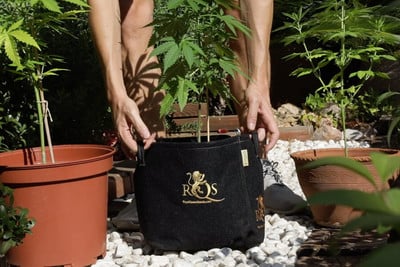

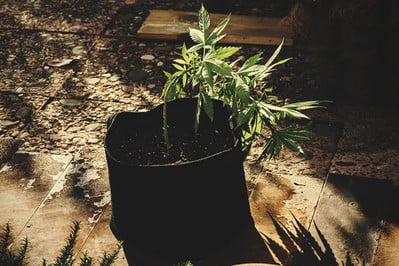

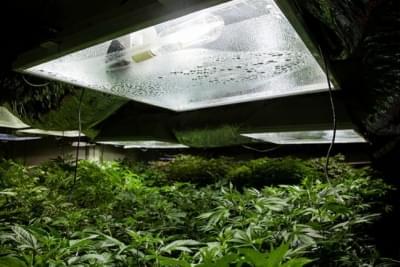
.jpg)








